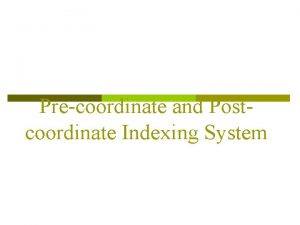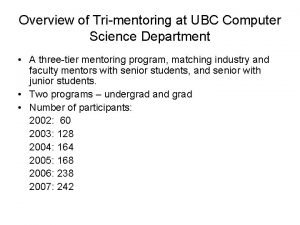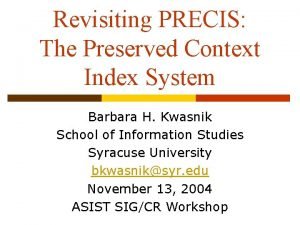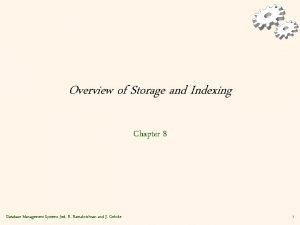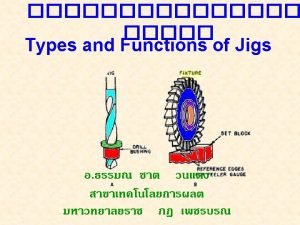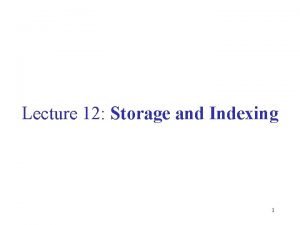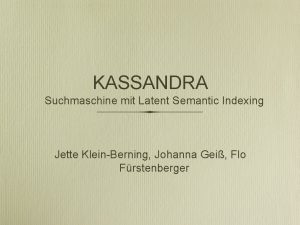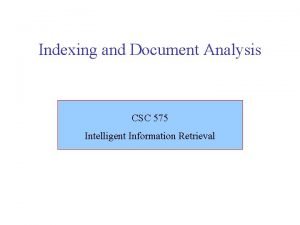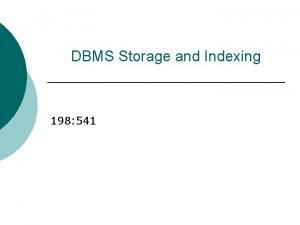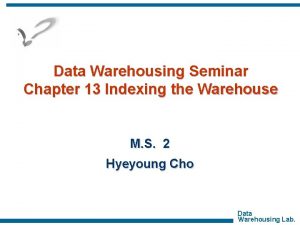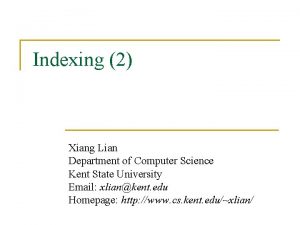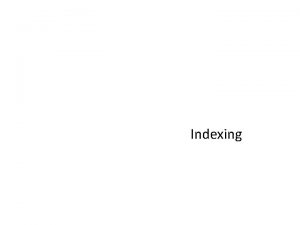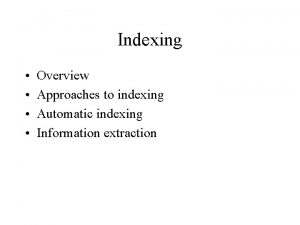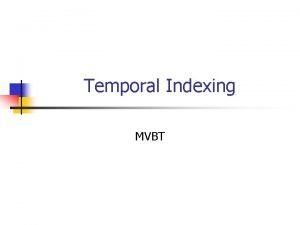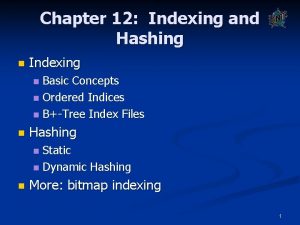Indexing 1 Xiang Lian Department of Computer Science


























































- Slides: 58

Indexing (1) Xiang Lian Department of Computer Science Kent State University Email: xlian@kent. edu Homepage: http: //www. cs. kent. edu/~xlian/ 1

Objectives n In this chapter, you will: q Get familiar with many indexing mechanisms: n n n n q q B+-tree, extensible hashing, bitmap Grid file Z-order, Hilbert curve Bitmap index Quadtree k-d tree R-tree, R+-tree, R*-tree SS-tree, SR-tree X-tree M-tree Embedding-based index Inverted index Local sensitive hashing Similarity search over indexes Distributed indexes 2

Outline n n n Introduction Indexing Mechanisms Similarity Search Over Indexes Indexing for High-Dimensional Data Permutation-Based Indexing 3

Introduction n In real applications, we usually collect data of large scale q q n Relational tables with millions of records (tuples) Sensor networks with thousands of sensor nodes, each collecting data such as temperature, humidity, etc. over time In mobile computing or location-based services, millions of mobile users move around in the city … Due to the large scale of data, it is very necessary to build indexes for accelerating the search over large data sets 4

The Reason for Indexes n n Consider a relational table with two attributes, PID (person ID) and Age Find those people with age between 20 and 30 q q q n Two records: {(PID: 1, Age: 25), (PID: 2, Age: 31)} How about 10 records? 100 records? 1, 000, 000 records? The search efficiency is not scalable for large data sets! 5

The Reason for Indexes (cont'd) n n Consider a relational table with two attributes, PID (person ID) and Age Find those people with age between 20 and 30 q n n 1, 000 records? Usually, the size of the answer set is much smaller than the total data size (e. g. , 1, 000)! Index is often used to reduce the search space, that is, access only a small number of records (<<1, 000) before we obtain answers 6

Outline n n n Introduction Indexing Mechanisms Similarity Search Over Indexes Indexing for High-Dimensional Data Permutation-Based Indexing 7

Relational Tables n n n Set of rows, or tuples (no duplicates) Each row describes a different entity Each column states a particular fact about each entity q Each column has an associated domain Student Table n ID 1111 2222 1234 9999 Name John Mary Bob Joan Address 123 Main 321 Oak 444 Pine 777 Grand Status fresh soph senior Domain of Status = {fresh, soph, junior, senior} 8

ER Model n Entity-Relationship (ER) Model q Entity n q Student, Course Relationship n enroll ID 1111 2222 1234 9999 Name John Mary Bob Joan Address 123 Main 321 Oak 444 Pine 777 Grand Status fresh soph senior Student Table Student enroll Course 9

Queries on Relational Tables n SQL – database language q q q FROM clause specifies the data source WHERE clause gives the conditions of tuples in the query result SELECT clause retains listed columns SELECT Name FROM Student WHERE Status = ‘soph’ and ID >1000 and ID<2000 equality query range query 10

Example: Enroll Table ID Heap File (random order) Crs. Code Semester GPA 666666 123456 987654 MGT 123 CS 305 F 1994 4. 0 S 1996 4. 0 F 1995 2. 0 717171 666666 765432 515151 CS 315 S 1997 4. 0 EE 101 S 1998 3. 0 MAT 123 S 1996 2. 0 EE 101 F 1995 3. 0 234567 CS 305 S 1999 page 0 page 1 4. 0 page 2 878787 MGT 123 S 1996 3. 0 11

Example: Enroll Table (cont'd) ID Crs. Code Semester GPA 111111 123456 MGT 123 F 1994 4. 0 CS 305 S 1996 4. 0 CS 305 F 1995 2. 0 123456 232323 234567 CS 315 S 1997 4. 0 EE 101 S 1998 3. 0 MAT 123 S 1996 2. 0 EE 101 F 1995 3. 0 234567 CS 305 S 1999 page 0 page 1 4. 0 page 2 Sorted File (sorted order) 313131 MGT 123 S 1996 3. 0 12

Indexing for Relational Tables n In relational databases, we can build indexes over one or multiple attributes in relational tables S Search key value Location Mechanism Location mechanism facilitates finding index entry for S Once index entry is found, the row can be directly accessed S S, ……. Index entries 13

Indexing for Relational Tables (cont'd) Integrated storage structure vs. separate storage structure Contains table and (main) index Index file n Location mechanism Index entries Storage structure for table 14

Clustered Secondary Index 1 2 3 8 10 15

Unclustered Secondary Index 1 2 3 8 10 10 1 3 2 8 16

Sparse vs. Dense Index n Dense index: has index entry for each data record q q n Unclustered index must be dense Clustered index need not be dense Sparse index: has index entry for each page of data file q Sparse index must be clustered 17

Sparse Vs. Dense Index Id Name Dept Sparse, clustered index sorted on Id Data file sorted on Id Dense, unclustered index sorted on Name 18

Indexes for Relational Tables n n n Index Sequential Access Method (ISAM) B+-tree Hashing 19

Index Sequential Access Method (ISAM) n Generally an integrated storage structure q n n Clustered, index entries contain rows Separator entry = (ki , pi); ki is a search key value; pi is a pointer to a lower level page ki separates set of search key values in the two subtrees pointed at by pi-1 and pi. 20

Location mechanism Example: Index Sequential Access Method 21

Overflow Chains - Contents of leaf pages change – Row deletion yields empty slot in leaf page – Row insertion can result in overflow leaf page and ultimately overflow chain – Chains can be long, unsorted, scattered on disk – Thus ISAM can be inefficient if table is dynamic 22

+ B -Tree Structure – Leaf level is a (sorted) linked list of index entries – Sibling pointers support range searches in spite of allocation and deallocation of leaf pages (but leaf pages might not be physically contiguous on disk) 23

Example: B+-Tree Search "pete" 24

Example: B+-Tree (cont'd) https: //en. wikipedia. org/wiki/B%2 B_tree 25

Insertion and Deletion in B+ Tree n n n Structure of tree changes to handle row insertion and deletion – no overflow chains Tree remains balanced: all paths from root to index entries have same length Algorithm guarantees that the number of separator entries in an index page is between /2 and q Hence the maximum search cost is log /2 Q + 1 (with ISAM search cost depends on length of overflow chain) 26

Handling Insertions - Example - Insert “vince” =2 27

Handling Insertions (cont’d) – Insert “vera”: Since there is no room in leaf page: 1. Create new leaf page, C 2. Split index entries between B and C (but maintain sorted order) 3. Add separator entry at parent level =2 28

Handling Insertions (con’t) – Insert “rob”. Since there is no room in leaf page A: 1. Split A into A 1 and A 2 and divide index entries between the two (but maintain sorted order) 2. Split D into D 1 and D 2 to make room for additional pointer 3. Three separators are needed: “sol”, “tom” and “vince” =2 29

Handling Insertions (cont’d) – When splitting a separator page, push a separator up – Repeat process at next level – Height of tree increases by one =2 30

Handling Deletions n Deletion cause page to have fewer than /2 entries q q q n Entries can be redistributed over adjacent pages to maintain minimum occupancy requirement Ultimately, adjacent pages must be merged, and if merge propagates up the tree, height might be reduced See book In practice, tables generally grow, and merge algorithm is often not implemented q Reconstruct tree to compact it 31

Hash Index n n n Index entries partitioned into buckets in accordance with a hash function, h(v), where v ranges over search key values Each bucket is identified by an address, a Bucket at address a contains all index entries with search key v such that h(v) = a Each bucket is stored in a page (with possible overflow chain) If index entries contain rows, set of buckets forms an integrated storage structure; else set of buckets forms an (unclustered) secondary index 32

Equality Search with Hash Index Location mechanism split bucket, instead of using an overflow chain Given v: 1. Compute h(v) 2. Fetch bucket at h(v) 3. Search bucket Cost = number of pages in bucket (cheaper than B+ tree, if no overflow chains) 33

Extensible Hashing n Example: q family of hash functions based on h: n n hk(v) = h(v) mod 2 k (use the last k bits of h(v)) At any given time a unique hash, hk , is used depending on the number of times buckets have been split 34

Example: Extendable Hashing k=2 Page capacity = 2 v h(v) pete 11010 00 mary 00000 01 jane 11110 10 11 bill 00000 john 01001 Location vince 10101 mechanism karen 10111 Extendable hashing uses a directory (level of indirection) to accommodate family of hash functions Suppose next action is to insert sol, where h(sol) = 10001. Problem: This causes overflow in B 1 35

Example: Extendable Hashing (cont’d) k=3 Page capacity = 2 000 001 010 011 100 101 110 111 Solution: 1. Switch to h 3 2. Concatenate copy of old directory to new directory 3. Split overflowed bucket, B, into B and B , dividing entries in B between the two using h 3 4. Pointer to B in directory copy replaced by pointer h(v) to B v current_hash identifies current hash function pete mary jane bill john vince karen sol 11010 00000 11110 00000 01001 10111 10001 36

Example: Extendable Hashing (cont’d) k=3 Page capacity = 2 000 001 010 011 100 101 110 111 Next action: Insert judy, where h(judy) = 00110 B 2 overflows, but directory need not be extended Problem: When Bi overflows, we need a mechanism for deciding whether the directory has to be doubled Solution: bucket_level[i] records the number of times Bi has been split. If current_hash > bucket_level[i], do not enlarge directory 37

Example: Extendable Hashing (cont’d) k=3 Page capacity = 2 v pete mary jane bill john vince karen sol judy h(v) 11010 00000 11110 00000 01001 10111 10001 00110 38

Spatial Data Points of Interests (POIs) https: //www. mcgill. ca/library/find/maps/epoi 39

Grid File n n Grid file – a spatial index In the case of 2 -dimensional spatial data P. Rigaux, M. Scholl, and A. Voisard. Spatial Databases - with application to GIS. Morgan Kaufmann, San Francisco, 2002. 40

Grid File (cont'd) n Fixed grid q q Partition a d-dimensional data space into cells of equal size Operations point query n n n Insertion Point query Window query range 41

Grid Construction without Overflow Pages Page Capacity = 4 (a) (b) (c) (d) 42

Fixed Grid for Rectangular Objects contains Rectangle intersects Cell is contained 43

Grid File Implementation Y grid array X n 2 -dimensional grid directory q q n Grid array: a 2 -dimensional array (disk-based), each element with a pointer, pi, pointing to a bucket Linear scales: two vectors (memory-based 1 -dimensional array), X and Y, indicating the range of cells on the two dimensions Example: q q Age vector X = [0, 20, 40, 60, 80] and last name vector Y = [A, H, O, U, Z] Search over grid with query (35, Lian) Exact match: at most 2 I/Os Range search: (1) use linear scales to obtain relevant cells; (2) access the grid array to obtain bucket addresses; and (3) retrieve data from buckets 44

Grid Related Research Topics n Grid Indexes q q For fixed grid, how to set the size of cells? Fixed grid vs. variable grid? Space partitioning vs. data partitioning? … 45

Space-Filling Curves n A space-filling curve defines a total order on the cells (or pixels) of a 2 D grid q q q n n Converting 2 -dimensional points/cells to a 1 -dimensional value The order partially preserves the proximity Two close cells in the data space are more likely to be close in the total order Z-order Hilbert curves 46

Space-Filling Curves (cont'd) Z-order or Z-ordering Hilbert curve 47

Z-Ordering Any object in the cell/pixel has an encoding: 01 10 11 10 01 00 00 01 10 11 48

Bit-Shuffling Any object in the cell/pixel has an encoding: 01 10 11 x y 01 10 10 z = (0 1 1 0)2 = 6 01 00 00 01 10 11 49

Bit-Shuffling (cont'd) n Interleaving the binary coordinate values yields binary zvalues 50

Indexing Over Z-Values n Given a number of objects o with 2 D coordinates (o. x, o. y) q q n Convert each object to a z-value, o. z Use a B+-tree index to organize z-values of all objects A range query in a 2 D data space can be mapped to a set of intervals for the converted z-values 51

Hilbert Curve n Hilbert Curve q q n Objects that are close in 1 D space are also close in 2 D space We want objects that are close in 2 D space to be close in 1 D space Z-order has some "jumps", whereas Hilbert curve does not Z-order Hilbert curve 52

Hilbert Curve (cont'd) n Recursive Definition q q 0 Hi (order-i) Hilbert curve for 2 i× 2 i array Given the location (2 D coordinates) of a cell, we can obtain a Hilbert value; vice versa 0 1 14 15 3 3 2 13 12 1 2 H 1 4 7 8 11 5 6 9 10 H 2 H 3 … 53

Bitmap Index n Bitmap index can be used in data warehouses q q Reduced response time for large classes of ad hoc queries Reduced storage requirements n n q Bit representations For example, if the domain of an integer attribute is {0, 1, 2, 3}, then bitmap needs 4 bits to represent, instead of 4 bytes (i. e. , 32 bits) Good performance with a relatively small number of CPUs or a small amount of memory n n Bitwise logical operations: AND, OR, NOT E. g. , range query [1, 2] q B 1 OR B 2 integers bits Bitmaps B 0~B 3 for attribute X 54

Quad Trees n A space-partitioning index root A 3 2 B 1 6 D 4 5 13 14 E C 11 12 F 19 55

Another Example of Quad Trees 56

Reading Materials n n (Grid file) P. Rigaux, M. Scholl, and A. Voisard. Spatial Databases - with application to GIS. Morgan Kaufmann, San Francisco, 2002. http: //bsolano. com/ecci/claroline/backends/download. php/TGlicm 9 z. X 2 Rl. X 3 Rl e. HRv. L 1 Nw. YXRp. YWx. EQn. NXa. XRo. QXBwb. Glj. YXRpb 25 Ub 0 d. JUy 5 w. ZGY %3 D? cid. Reset=true&cid. Req=CI 1314 (Bitmap index) P. Nagarkar, K. S. Candan, and A. Bhat. Compressed Spatial Hierarchical Bitmap (c. SHB) Indexes for Efficiently Processing Spatial Range Query Workloads. In PVLDB, 8(12), pages 1382 -1393, 2015. http: //dl. acm. org/citation. cfm? id=2824038 (Quadtree) H. Samet and R. E. Webber. Storing a collection of polygons using quadtrees. In ACM Trans. Graph, 1985. https: //pdfs. semanticscholar. org/65 ee/4429 b 5509173 f 12309539 e 809 ac 533 e 846 90. pdf H. Samet. Foundations of Multidimensional and Metric Data Structures. The Morgan Kaufmann Series in Computer Graphics and Geometric Modeling, ISBN: 0123694469, 2005. http: //dl. acm. org/citation. cfm? id=1076819 57

Exercises n Install Apache Hadoop on your machine q n http: //hadoop. apache. org/ Read tutorials of Amazon AWS q https: //aws. amazon. com/ 58
 Xiang tian ge
Xiang tian ge Post-coordinate indexing
Post-coordinate indexing Manual indexing vs automatic indexing
Manual indexing vs automatic indexing Bup lian
Bup lian Uga pols 1101
Uga pols 1101 Lian butcher
Lian butcher Ni ji dian qi chuang
Ni ji dian qi chuang Maksud lian
Maksud lian Rukun nikah
Rukun nikah Ucl university computer science
Ucl university computer science Northwestern computer science department
Northwestern computer science department Computer science department rutgers
Computer science department rutgers Computer science department stanford
Computer science department stanford Florida state computer science
Florida state computer science Ubc computer science department
Ubc computer science department Bhargavi goswami
Bhargavi goswami Computer science department columbia
Computer science department columbia Chain procedure in library science
Chain procedure in library science Vex xiang
Vex xiang Chengxiang zhai
Chengxiang zhai Liu xiang weightlifter
Liu xiang weightlifter Cheng xiang zhai
Cheng xiang zhai Liu xiang
Liu xiang Xiang yu liu bang
Xiang yu liu bang Cheng xiang zhai
Cheng xiang zhai Its rosewhatt
Its rosewhatt Cheng xiang zhai
Cheng xiang zhai Cheng xiang zhai
Cheng xiang zhai Xiang yang liu
Xiang yang liu Xiang cheng mit
Xiang cheng mit Miscosoft forms
Miscosoft forms Jessie xiang
Jessie xiang Xiang jiao ping guo
Xiang jiao ping guo Cheng xiang zhai
Cheng xiang zhai Perfume xia xiang
Perfume xia xiang Vex xiang
Vex xiang Xiang cheng mit
Xiang cheng mit Yongqing xiang
Yongqing xiang Favorite subject science
Favorite subject science Department of forensic science dc
Department of forensic science dc Oh.nesinc
Oh.nesinc Material science iit delhi
Material science iit delhi Tum department of electrical and computer engineering
Tum department of electrical and computer engineering Computer engineering department
Computer engineering department 40/8 is the indexing for the divisions of
40/8 is the indexing for the divisions of Role of precis in indexing
Role of precis in indexing Alphabetic indexing rules
Alphabetic indexing rules Non-numerical unstructured data indexing
Non-numerical unstructured data indexing Tree based indexing in dbms
Tree based indexing in dbms Leaf drill jig assembly drawing
Leaf drill jig assembly drawing Image indexing
Image indexing Nmcn indexing
Nmcn indexing Tree based indexing in dbms
Tree based indexing in dbms Kwoc indexing
Kwoc indexing Latent semantic indexing
Latent semantic indexing R indexing list
R indexing list Csc // s-1-5-21 indexing
Csc // s-1-5-21 indexing Clustered b+ tree
Clustered b+ tree Data warehouse seminar
Data warehouse seminar

